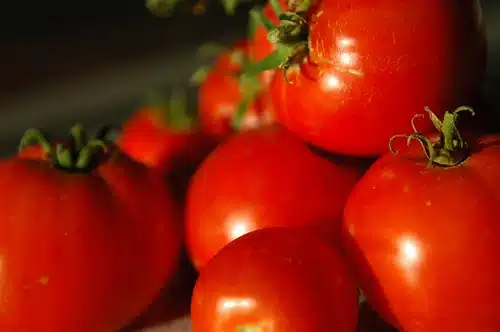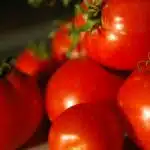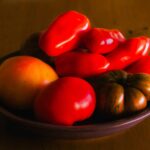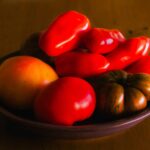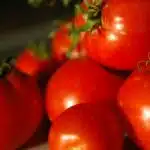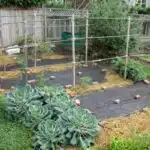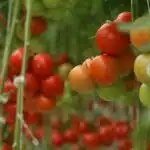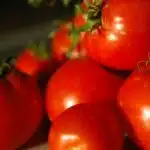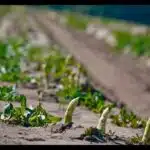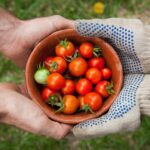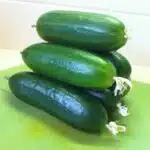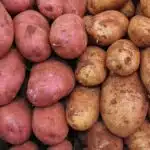As a horticulturalist or garden expert, one of the most frequently asked questions by garden enthusiasts is, “How do I know when my tomatoes are ripe?” The answer to this question is not as straightforward as it may seem. Tomatoes come in various shapes, sizes, and colors that signal different stages of ripeness. Furthermore, factors such as temperature, soil moisture levels, and genetics can significantly affect the ripening process.
To accurately determine when your tomatoes are ripe, it’s essential to understand their growth and development stages. This knowledge will help you harvest your tomatoes at the right time to ensure maximum flavor and nutrition. In this article, we’ll explore the various signs that indicate a tomato is ripe, including color changes, texture changes, and aroma. We’ll also provide tips on how to store and handle your harvested tomatoes to prolong their freshness. By the end of this article, you’ll be equipped with the knowledge you need to confidently identify when your tomatoes are ready for harvest.
Understanding Tomato Growth And Development
Tomato plant care is essential to ensure a bountiful harvest. To achieve optimal results, it’s crucial to plant tomatoes in an area with good drainage and full sun exposure. The soil must be rich in nutrients and slightly acidic, with a pH level of 6 to 6.8.
Tomatoes grow best when the temperature stays between 60°F to 85°F. Temperatures above or below this range can stunt growth or cause damage to the plant. It’s also important to water tomato plants regularly but not excessively, as too much water can cause root rot and other diseases.
Understanding tomato growth and development is key to identifying when your tomatoes are ripe. Different types of tomatoes have varying ripening characteristics that are influenced by factors such as genetics, climate conditions, and growing methods. In the next section, we’ll explore these differences further and provide tips for identifying when your tomatoes are ready for harvest.
Different Types Of Tomatoes And Their Ripening Characteristics
Tomatoes are an incredibly versatile and delicious fruit that can be used in a variety of dishes. However, knowing when your tomatoes are ripe is essential to getting the most out of them. Understanding tomato growth and development can help you determine when your fruit is ready to be harvested, but it’s also important to know the different types of tomatoes and their ripening characteristics.
Tomato varieties come in many shapes, sizes, and colors, each with its unique ripening patterns. Some varieties ripen all at once while others ripen slowly over time. For example, cherry tomatoes tend to ripen early and continuously throughout the season, while beefsteak tomatoes take longer but produce larger fruits. Knowing the variety you are growing will give you a good idea of when to expect ripe fruit.
Harvesting techniques can also affect tomato ripening. If you pick your tomatoes too early or too late, they may not have reached their full flavor potential or may have already started to spoil. To ensure maximum flavor and nutrition from your tomatoes, harvest them when they are fully ripe but still firm. You can tell if a tomato is ripe by gently squeezing it – if it yields slightly under pressure and has a bright color, it’s ready to be harvested.
Factors affecting tomato ripening include temperature, humidity, light exposure, and even the presence of ethylene gas produced by other fruits nearby. In the next section, we will explore these factors in more detail so that you can understand how they impact your tomato plants’ growth and development. By understanding these factors’ interactions with one another, you’ll be better equipped to create optimal growing conditions for your garden’s success.
Factors Affecting Tomato Ripening
Tomato ripening is a process that depends on various factors, including environmental conditions and genetic traits. Environmental conditions such as temperature, humidity, and sunlight have a significant impact on the ripening process. Tomatoes require sufficient exposure to light and warmth to ripen properly. A temperature range of 68-77°F (20-25°C) is optimal for tomato ripening, while high temperatures above 86°F (30°C) can cause uneven ripening or even sunscald.
Genetic traits also play a role in determining the ripening time of tomatoes. Tomato varieties have different maturation periods, with some taking longer than others to reach full maturity. The level of acidity in the fruit can also affect its rate of ripening. For instance, tomatoes with higher acidity levels tend to take longer to ripen compared to those with lower acidity levels.
Understanding the factors that impact tomato ripening is crucial for gardeners and farmers who want to achieve optimal yields. By providing the right environmental conditions such as adequate sunshine and temperature regulation, coupled with careful selection of tomato cultivars best suited for their growing region’s genetic traits, farmers and gardeners can ensure their tomatoes reach full maturity before harvesting. In the next section, we will discuss how you can determine the best time to harvest your tomatoes based on their appearance and texture without causing damage to the fruit itself.
Determining The Best Time To Harvest Tomatoes
Tomatoes are one of the most popular garden crops, but it can be challenging to know when they are ripe and ready for harvesting. Understanding the tomato ripening stages is essential to ensure maximum flavor and nutrient content in your tomatoes. The first stage is the green stage when the tomato is still firm, and its skin color is green. The second stage is the breaker stage when there is a slight change in color as the tomato starts to ripen. Finally, the third stage is the mature-green stage, where there is a significant color change from green to yellow or pink.
Harvesting tomatoes at their peak ripeness ensures that you get maximum flavor and nutrition from them. When harvesting your tomatoes, it’s best to use scissors or pruning shears rather than twisting them off by hand. This will prevent damage to the plant’s stem, which can lead to disease and reduced yields in future harvests. Additionally, it’s important to only harvest tomatoes that have fully ripened to avoid any unwanted tartness.
To determine if your tomatoes are ripe, look out for these three indicators:
- Firmness – Ripe tomatoes should be slightly soft when gently squeezed.
- Skin color – As mentioned earlier, mature tomatoes will have a significant color change from green (or yellow) to red (or other colors depending on the variety).
- Flavor – The best way to tell if your tomato is ripe is by tasting it! A fully ripened tomato should have a sweet and juicy taste.
Color changes as indicators of tomato ripeness will be discussed in further detail in the next section. By understanding how to identify different stages of ripeness and using proper harvesting techniques, you can enjoy delicious home-grown tomatoes all season long!
Color Changes As Indicators Of Tomato Ripeness
Transition: Timing is everything when it comes to harvesting tomatoes. Knowing the optimal time for picking your prized produce ensures that you get the most out of your efforts in the garden. However, determining the right moment to harvest can be a daunting task for many gardeners. Fear not! There are several tomato ripeness indicators that you can use to make sure you’re picking your tomatoes at their peak.
First and foremost, look at the color of your tomatoes. The most common indicator of a ripe tomato is its color. As they mature, tomatoes will begin to change from green to yellow, pink, or red depending on their variety. Keep in mind that some tomato varieties never turn fully red; instead, they may have other color changes such as deepening their green or turning brownish-purple. Refer to your seed packet or plant tag for specific information about your cultivar.
Another important indicator of tomato ripeness is texture. When a tomato reaches maturity, it should feel firm but not hard when gently squeezed. If it feels mushy or has soft spots, then it’s overripe and should be harvested immediately. Conversely, if it feels rock hard with no give whatsoever, then it’s not yet ready and needs more time on the vine. A good way to test for ripeness is by using all five fingers to gently press around the fruit’s surface.
Transition: While color and texture are reliable indicators of tomato ripeness, there are additional signs you can look for before plucking those precious fruits from the vine. In the next section, we’ll explore how texture changes can also help determine if your tomatoes are ready for harvesting.
Keywords: Tomato ripeness indicators, harvesting techniques
Note: The subsequent section will focus on “Texture Changes as Indicators of Tomato Ripeness”.
Texture Changes As Indicators Of Tomato Ripeness
Tomato firmness is one of the primary indicators of ripeness. As tomatoes mature, they become increasingly soft to the touch. The skin may even begin to wrinkle slightly in some varieties. However, it is important not to let them become too soft, as this can indicate overripeness and loss of flavor.
Skin texture is another indicator of tomato ripeness. When a tomato is ripe, its skin should be smooth and taut. Avoid any tomatoes with cuts or bruises, as these can lead to spoilage and affect the overall quality of the fruit. Additionally, look for uniform coloring across the entire surface of the tomato.
By paying attention to tomato firmness and skin texture, you can ensure that you are selecting ripe tomatoes at their peak flavor and nutrition levels. Remember that different varieties may have slightly different characteristics when it comes to ripeness indicators, so it’s always a good idea to consult with a trusted gardening resource or expert for specific guidance on your chosen variety. In the next section, we will explore how aroma changes can also be used as an indicator of tomato ripeness.
Aroma Changes As Indicators Of Tomato Ripeness
The aroma of a tomato increases as it ripens, making it easier to detect when it is ready. As tomatoes ripen, the smell associated with them also changes, becoming sweeter and more intense. The more developed the aroma of a tomato is, the more ripe it is likely to be. The intensity of the aroma is a reliable indicator of the ripeness of a tomato, and can be used as a guide in determining when to harvest.
Aroma Increase
One of the most reliable ways to determine if your tomatoes are ripe is by paying attention to their scent. As tomatoes mature, they emit a distinct aroma that can be easily detected by the human nose. This scent is caused by the release of certain chemicals that signal ripening stages.
Tomato scent intensity can vary depending on the variety and growing conditions. However, as a general rule, the stronger and more pungent the smell, the riper the tomato. You can test this by gently rubbing or pinching a tomato to release its aroma. If it has a sweet and fragrant smell, then it’s likely ready for harvesting.
It’s important to note that not all tomatoes will have a strong scent when ripe. Some varieties are more subtle in their fragrance, while others may not emit any noticeable odor at all. Therefore, it’s essential to also pay attention to other physical indicators like color and texture when determining if your tomatoes are ready for picking.
Smell Change
As a horticulturalist or garden expert, it is important to understand the various indicators of tomato ripeness, including their aroma changes. Smell change is one of the most reliable ways to determine if your tomatoes are ripe and ready for harvesting. Tomatoes emit a distinct aroma as they mature, caused by the release of certain chemicals that signal their ripening stages. This fragrance can be easily detected by the human nose, and its intensity may vary depending on the variety and growing conditions.
The aroma changes in tomatoes can also help in determining whether they are suitable for cooking or preservation techniques. The sweet and fragrant smell indicates that the tomato is ripe and perfect for immediate use in recipes such as salads or sandwiches. On the other hand, less fragrant tomatoes may still be suitable for cooking but may require longer cooking times to achieve desired results. Additionally, some varieties are better suited for preservation techniques like canning or freezing when they are not yet fully ripe.
It’s essential to pay attention to other physical indicators like color and texture when determining if your tomatoes are ready for picking. However, understanding how aroma changes indicate tomato ripeness can significantly aid gardeners and home cooks alike in harvesting perfect tomatoes for immediate consumption or preservation purposes. By incorporating this knowledge into gardening practices, you can ensure that you are getting the most out of your tomato plants while providing delicious produce for yourself and others.
Conducting A Taste Test To Determine Tomato Ripeness
When it comes to determining tomato ripeness, there are a few visual indicators that gardeners look for. First, tomatoes should be fully colored and have a glossy appearance. For some varieties, this means they will be a deep red color, while others may have a yellow or greenish tint until they ripen fully. Additionally, ripe tomatoes should be firm but yield slightly to gentle pressure.
While these visual indicators can be helpful in gauging tomato ripeness, the most reliable method is conducting a taste test. To do this, simply pick a tomato from the vine and take a bite. Ripe tomatoes will have a sweet and juicy flavor with just the right balance of acidity. If the tomato tastes bland or lacks sweetness, it may need more time on the vine to ripen fully.
It’s important to note that taste can vary depending on personal preference and variety of tomato. Some people prefer their tomatoes slightly under-ripe for their tartness and firmer texture. However, if you’re looking for peak flavor and sweetness, conducting a taste test is the best way to ensure your tomatoes are at their ripest.
Moving forward from conducting the tomato ripeness taste test, there are several tips for properly storing and handling tomatoes that can help extend their shelf life and preserve their quality.
Tips For Properly Storing And Handling Tomatoes
After conducting a taste test to determine tomato ripeness, the next step is to properly store and handle your harvest. Storing techniques are crucial in extending the shelf life of your tomatoes, ensuring that they remain fresh and flavorful for longer periods.
One essential tip when storing tomatoes is by keeping them at room temperature. Refrigerating them can cause the fruit to lose flavor and become mealy. However, if you have ripe tomatoes that you cannot consume immediately, you can store them in the refrigerator but make sure to let them sit at room temperature for a few hours before eating.
Another technique is by placing your harvested tomatoes in a single layer inside a cardboard box or paper bag. This will prevent bruising and also provide good ventilation. Avoid stacking them on top of each other as this can cause the bottom ones to get squished or rotten quickly.
- Keep your harvested tomatoes away from direct sunlight.
- Do not wash your tomatoes before storing.
- Store under-ripe tomatoes stem side down.
- Use up any overripe or damaged tomatoes first.
By following these tips, you can extend the shelf life of your harvested tomatoes and enjoy fresh-tasting fruits for an extended period. Proper handling and storage techniques are essential in maintaining the quality of your produce.
Extending The Shelf Life Of Your Harvested Tomatoes
A ripe tomato is like a sweet, juicy kiss from summer itself. But once harvested, the countdown begins on how long they will last before spoiling. Tomato preservation is a crucial step in maximizing the shelf life of your harvest. There are several methods for preserving tomatoes, but canning is one of the most reliable and popular methods.
Tomato canning involves sealing cooked or raw tomatoes in a jar with acid to prevent bacterial growth. There are two types of canning methods: water bath and pressure canning. Water bath canning is best for high-acid foods like tomatoes as it uses boiling water to create a vacuum seal. Pressure canning, on the other hand, requires a specialized device that heats and pressurizes jars filled with low-acid foods like meat and vegetables.
Canning not only extends the shelf life of your tomatoes but also allows you to enjoy their rich, intense flavor all year round. Properly canned tomatoes will keep for up to a year without losing their taste or nutritional value. So if you find yourself with an abundance of ripe tomatoes, don’t let them go to waste – try your hand at tomato preservation through canning.
To avoid wasting time and effort in tomato preservation, there are common mistakes you should avoid when harvesting tomatoes. One mistake is picking them too early before they fully ripen as this results in poor quality fruit that lacks flavor and sweetness. Another mistake is leaving them on the vine for too long after they have ripened as this increases the risk of spoilage and insect damage. By learning these common mistakes, you’ll be able to maximize your harvest’s potential and enjoy delicious tomato dishes all year round.
Common Mistakes To Avoid When Harvesting Tomatoes
When it comes to harvesting tomatoes, there are a few common mistakes that gardeners tend to make. One of the biggest mistakes is harvesting the tomatoes too early. It can be tempting to pluck them off the vine as soon as they start to turn red, but this often results in underripe fruit that lacks flavor and sweetness. To ensure that your tomatoes are fully ripe, wait until they are completely red and slightly soft to the touch.
Another mistake that many gardeners make is not giving their tomatoes enough time to ripen on the vine. Tomatoes need warmth and sunlight in order to ripen properly, so be sure to give them plenty of both. If you live in an area with a short growing season, consider using a greenhouse or other protective structure to extend your tomato harvest into the fall.
To improve tomato ripening, there are a few tips you can follow. First, try removing some of the leaves from your tomato plants. This will allow more sunlight and warmth to reach the fruit, which will help them ripen faster. You should also avoid overwatering your tomato plants, as this can lead to splitting and uneven ripening.
In order to get the best possible harvest from your tomato plants, it’s important to avoid these common harvesting mistakes and take steps to improve ripening. With a little bit of patience and attention, you can enjoy delicious, ripe tomatoes all summer long.
Transition: While following these tips can certainly help improve tomato ripening, sometimes issues still arise. The next section will cover troubleshooting common problems that may arise during tomato ripening.
Troubleshooting Issues With Tomato Ripening
As the saying goes, “you reap what you sow.” The same is true when it comes to tomato ripening. You need to know when your tomatoes are ripe to get the most out of your gardening efforts. One common mistake that gardeners make is harvesting their tomatoes too early or too late. This can lead to a lack of flavor and texture in your tomatoes.
To determine if your tomatoes are ripe, look for signs of color change. Tomatoes should be fully red or pink, depending on the variety. Another indicator of ripeness is firmness. Ripe tomatoes should give slightly when squeezed but not be mushy or too soft. Additionally, you can check for ethylene production by smelling the stem end of the tomato. A sweet smell indicates that the tomato is ripe.
If you’re having trouble with tomato ripening, there are a few things that may be inhibiting it. Ripening inhibitors like cold temperatures and lack of sunlight can slow down the process. Ethylene production also plays a role in ripening, as it triggers other fruits around it to ripen faster. To encourage ripening, store your tomatoes at room temperature in a paper bag with an apple or banana to boost ethylene production.
As a horticulturalist, understanding tomato ripening is crucial for getting the best crop possible from your garden. By avoiding common mistakes and paying attention to color change and firmness, you can ensure that your tomatoes are perfectly ripe when harvested. In the next section, we’ll explore different ways to harvest your tomatoes for various uses so that none go to waste!
Harvesting Tomatoes For Different Uses
Harvesting tomatoes for eating requires that the fruit be ripe and fully colored, with a deep red color. When harvesting for canning, tomatoes should be slightly under-ripe and picked at the firmest stage of maturity. For both, the tomato should be free of blemishes, soft spots, and cracking. The best time to harvest tomatoes for any use is in the morning, when the temperature is cooler.
Harvesting For Eating
As a tomato lover, there is nothing more satisfying than eating a perfectly ripe tomato. However, it can be challenging to determine when your tomatoes are ready for harvesting, especially if you’re new to gardening. Harvesting at the right time is crucial, as it affects the flavor and texture of the fruit.
When harvesting tomatoes for preservation, it’s best to wait until they’re fully ripe. The tomato should be firm but slightly soft when squeezed gently. The skin should be smooth and free from any blemishes or cracks. Once harvested, store them at room temperature until they’re fully ripe before processing them for preservation.
On the other hand, when picking tomatoes for cooking, you don’t need to wait until they’re fully ripe. For example, if you plan on making a sauce, harvesting slightly unripe tomatoes will give your sauce a tangy flavor profile that works well with spices and herbs. Additionally, some recipes may call for firm tomatoes that hold their shape after cooking. In such cases, harvest when the fruit is still greenish-yellow in color and feels firm when touched.
In conclusion, knowing when to harvest your tomatoes depends on what you plan on using them for—preservation or cooking. Always check the ripeness level by examining its color and texture before picking them off the vine. By following these guidelines, you’ll ensure that your tomatoes are perfect in taste and texture every time!
Harvesting For Canning
Harvesting tomatoes for different uses requires careful consideration of the fruit’s ripeness level. While fully ripe tomatoes are ideal for fresh consumption, slightly unripe ones are better for cooking and preserving. Canning techniques and preserving methods can help extend the shelf life of your tomato harvest, allowing you to enjoy them all year round.
When harvesting tomatoes for canning, it’s crucial to choose fruits that are free from any blemishes or cracks. These imperfections can compromise the quality of your preserved tomatoes and increase the risk of spoilage. Additionally, you should aim to harvest fruits that are at their peak ripeness level to ensure maximum flavor and texture retention during the canning process.
To prepare tomatoes for canning, it’s recommended to blanch them first before removing their skins and seeds. This step helps preserve their color and flavor while also reducing the likelihood of bacteria growth in your canned goods. Once blanched, you can chop or crush your tomatoes as desired before packing them into sterilized jars with added salt or acid (such as lemon juice) to prevent spoilage. With proper harvesting and preservation techniques, you can enjoy delicious home-canned tomato products throughout the year.
Recipes For Using Ripe Tomatoes
Once you have determined that your tomatoes are ripe, it is time to start thinking about how to use them. Tomato-based dishes are some of the most popular and versatile recipes out there, and there are countless ways to prepare them. From simple salads to complex sauces, the possibilities are endless.
One great way to preserve ripe tomatoes is by canning them. This process involves boiling jars filled with tomato sauce or diced tomatoes in a water bath for a certain amount of time. Canning allows you to enjoy your tomatoes throughout the year, even when they are not in season. Another option is freezing your ripe tomatoes. Simply blanch them for a few seconds in boiling water, then plunge them into ice-cold water before peeling and freezing them whole or chopped.
If you want to use your ripe tomatoes right away, there are plenty of recipes to choose from. Some classics include caprese salad, gazpacho soup, and bruschetta. For something a little more substantial, try making tomato sauce for pasta or pizza, or roast the tomatoes with garlic and herbs for a flavorful side dish. The possibilities are truly endless when it comes to cooking with ripe tomatoes.
Now that you know all about using and preserving ripe tomatoes, it’s time to start cooking! Whether you’re looking for a quick weeknight dinner or an elaborate feast, incorporating fresh produce like ripe tomatoes into your meals is always a good choice. So get creative in the kitchen and enjoy the fruits of your labor!
Conclusion: Enjoying The Fruits Of Your Labor
As we move away from discussing tomato recipes, it is important to note that the joy of growing your own tomatoes extends far beyond the kitchen. Celebrating harvest season is an exciting time for gardeners and farmers alike. When it comes to determining whether your tomatoes are ripe, there are a few indicators to consider.
Firstly, one can look at the color of the tomato. Most often, ripe tomatoes will have a deep red hue, although some varieties may be orange or yellow when fully mature. Additionally, the skin should be firm but slightly yielding when pressed. Ripe tomatoes should also give off a sweet aroma.
If you find yourself with an abundance of ripe tomatoes, it is important to take measures to preserve them for future use. One popular method is canning, which involves sterilizing jars and sealing them with processed tomato sauce or whole tomatoes. Another option is dehydrating your excess tomatoes, either by slicing them thinly and using a dehydrator or oven on low heat until they become crispy chips or drying them as whole fruits under the sun.
As gardeners and tomato enthusiasts alike know well, harvesting ripe tomatoes marks the end of one journey and the beginning of another. By keeping in mind these key indicators of ripeness and preserving excess fruits through canning or drying techniques, you can continue to enjoy your hard-earned crop throughout the year.
Conclusion
Tomato ripening is a complex process that involves various factors such as genetics, environmental conditions, and cultural practices. Understanding the growth and development of tomatoes is crucial for determining the best time to harvest them. Different types of tomatoes have their own unique ripening characteristics, which can be affected by factors such as temperature, humidity, and sunlight.
One of the most reliable indicators of tomato ripeness is color changes. As tomatoes mature, they change from green to yellow or red depending on the variety. However, it’s important to note that color alone is not always a reliable indicator of ripeness, as some varieties may stay green even when fully ripe.
To troubleshoot issues with tomato ripening, gardeners should look out for common problems such as blossom end rot or cracking. These issues can be caused by factors such as inconsistent watering or excessive sunlight exposure. Harvesting tomatoes at the right time can also depend on their intended use – for example, if you plan to make sauces or salsas with your ripe tomatoes, you may want to wait until they are fully ripe and juicy.
Ultimately, growing and harvesting tomatoes requires patience and attention to detail. By understanding the various factors that affect tomato ripening and using color changes as a reliable indicator of maturity, gardeners can enjoy the fruits of their labor in a variety of delicious recipes. From tangy tomato salads to savory pasta sauces, ripe tomatoes are a versatile ingredient that can add flavor and nutrition to any meal.
Image Credits
- “Tomatoes” by St0rmz (featured)

